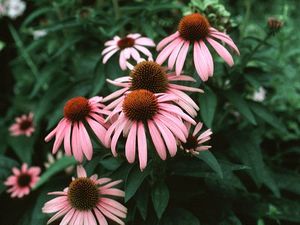Echinacea purpurea ''Magnus''
Purple Coneflower (Transitional Plant)
This perennial is quite similar to the Midwestern native, Echinacea purpurea (Purple Coneflower), but differs in a few aspects. The flowers of Magnus are larger and rosy purple with a dark disk or cone, and its rays (petals) do not point down.
Additional Information:
Purple Coneflower is a native wildflower that has migrated from the wild to become a mainstream garden perennial in just the last 25 years. As with many of our native plants, European gardeners were the first to recognize its garden worthiness and spearhead the widespread garden use of purple coneflower. The cultivar Magnus was selected by one of these European nurserymen for its compact habit of growth and flat flower head. Perennial plant growers are so enamored with Magnus that they bestowed the title of National Perennial Plant of the Year for 1998.
Height
30-36 Inches
|
 |
Spread
12-18 Inches
|
|
|
 |
Bloom/Seasonal Color
Deep Pink / Rose
|
USDA Hardiness Zone 3-8
Home Owner Growing and Maintenance Tips:
Purple Coneflower is a great border plant and cut flower that should be grown in full sun to light shade. Light shade will enhance the rich colors of the petals in hot weather. It is relatively drought resistant and should be divided in the spring every four years.
Characteristics & Attributes
Hydrologic Designation
|
Nature Attracting
|
Root
|
Season of Interest
| • |
Mid (May-June) |
| • |
Late (July-frost) |
|
Soil Moisture
|
Special Uses
| • |
Fresh Cut Flower |
| • |
Containers |
|
Sun Exposure
| • |
Full Sun |
| • |
Medium Sun/Average Shade |
|
Wildlife Benefit
| • |
Food/Birds |
| • |
Butterfly Nectar |
|

